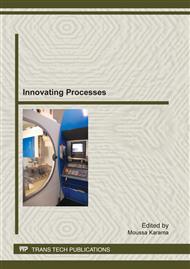[1]
E.D. Mielnieck, Metal working science and engineering, Mc Graw-Hill, Inc, (1991).
Google Scholar
[2]
Erman Tekkaya, J. of Materials Processing Technology, Vol. 103, Issue 1, (2000), pp.14-22.
Google Scholar
[3]
S. H. Zhang, J. of Materials Processing Technology, vol. 91, 1999, 236-244.
Google Scholar
[4]
L. H. Lang, Z. R. Wang, D. C. Kang, S. J. Yuan, S. H. Zhang, J. Danckert, K. B. Nielsen, J. of Materials Processing Technology, vol. 151, 2004, 165-177.
Google Scholar
[5]
J. Lemaitre, J. of Eng. Mat. Tech. vol. 107, 1985, 83-89.
Google Scholar
[6]
P. Germain, Q-S. Nguyen, P. Suquet. J. of Eng. Mech, vol. 50, 1983, 1010-1020.
Google Scholar
[7]
J-R. Rice et D-M. Tracy, J. of Mech. Phys, vol 17, 1969, 201-217.
Google Scholar
[8]
A-L. Gurson, J. of Eng. Mat. Tech. Vol. 99, (1977).
Google Scholar
[9]
V. Tvergaard. J. of Advances in Appl. Mech, vol. 27, 1990, 83-151.
Google Scholar
[10]
A. Cherouat, K. Saanouni, Y. Hammi. I. J. of Mech. Sciences, vol. 44 (12), 2002, 2427-2446.
Google Scholar
[11]
F.M. Andrade Pires, E.A. de Souza Neto, D.R.J. Owen. Computer Methods in Applied Mechanics and Engineering, vol. 193 (48-51), 5223-5256, (2004).
DOI: 10.1016/j.cma.2004.01.038
Google Scholar
[12]
M. Ayadi, A. Cherouat, MA Rezgui & N Mezghani. Materials Science Forum, 2009, vol. 614, 129-134.
DOI: 10.4028/www.scientific.net/msf.614.129
Google Scholar
[13]
R. Hill, A theory of yielding and plastic flow of anisotropic metals, Royal Soc., London Proc., 1948, p.281.
Google Scholar
[14]
L. Giraud-Moreau, Borouchaki, H & A. Cherouat, A Remeshing Procedure for Numerical Simulation of Forming Processes in Three Dimensions, New York: Springer ISBN 3-540-34957-X, 127-143, (2006).
DOI: 10.1007/978-3-540-34958-7_8
Google Scholar
[15]
Borouchaki, A. Cherouat, P. Laug and K. Saanouni. C.R. Mecanique 330, 709-716, (2002).
DOI: 10.1016/s1631-0721(02)01519-x
Google Scholar
[16]
M. Ainsworth, J. T Oden. Computer Methods in Applied Mechanics and Engineering. Vol. 101, 73-96, (1992).
Google Scholar
[17]
J. T. Oden, L. Demkowicz, W. Rachowicz and T. A. Westermann. Computer methods in applied mechanics and engineering, Vol. 77, 113-180, (1989).
DOI: 10.1016/0045-7825(89)90130-8
Google Scholar
[18]
I. Babuška, L. Planck and R. Rodriguez. Computer Methods in Applied Mechanics and Engineering. Vol. 101, 97-112, (1992).
Google Scholar
[19]
P. Coorevits, E. Bellenger, in: Alternative mesh optimality criteria for hadaptive finite element method. Finite elements in analysis and desig, Elsevier. Vol. 40, 2195-1215, (2004).
DOI: 10.1016/j.finel.2003.08.007
Google Scholar
[20]
J. -W. Cho and D. -Y. Yang. A mesh refinement scheme for sheet metal forming analysis. Proc. of the 5th International Conference, NUMISHEET'02, 307-312, (2002).
Google Scholar
[21]
Ho Choi, Muammer Koç, Jun Ni. Finite Elements in Analysis and Design, Vol. 43, Issue 3, 2007, 234-246.
Google Scholar
[22]
Jieshi Chen, Xianbin Zhou, Jun Chen. Journal of Materials Processing Technology, vol. 210, Issue 2, 19, 2010, 315-322.
Google Scholar
[23]
G. Nefussi, A. Combescure. International Journal of Mechanical Sciences, Vol. 44, Issue 5, 2002, 899-914.
Google Scholar


